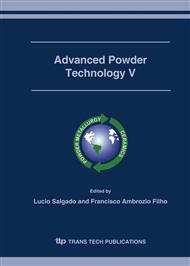p.425
p.432
p.438
p.444
p.449
p.456
p.461
p.467
p.473
Influence of the Type of Dispersant on the Properties of Casting Slips of Porcelains with Soda-Lime Glass
Abstract:
The use of glass residues for the reduction of firing temperature of ceramic materials products has become an attractive alternative. For pressed or extruded products, such as tiles and bricks, the use of glass is sufficiently simple, since only milling and mixing to the industrial mass batch in partial substitution of conventional fluxes are necessary. However, in slip casting products, such as china and porcelains, the glass presence destabilizes the casting slip. This is the motivation of this work. Different types of dispersants and their influence on the properties of slips containing glass waste were evaluated. The experimental results showed that the use of conventional dispersant (sodium silicate) is not adequate. The stabilization of slips was possible only with organic dispersants. Therefore, the factors that determine the success or failure of dispersants were also analyzed.
Info:
Periodical:
Pages:
449-455
Citation:
Online since:
November 2006
Authors:
Keywords:
Price:
Сopyright:
© 2006 Trans Tech Publications Ltd. All Rights Reserved
Share:
Citation:


